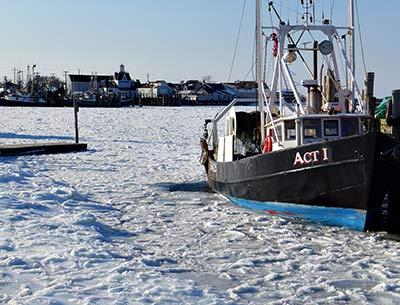Winter on the Rocks

Consider ice: It can be a bulldozer that lifts a few thousand pounds of buoy off the bottom and carries it to new location a half mile away. It can be millions of tiny crystalline blades that scalp the terra firma from the face of a bluff. Ice can suck a piling from deep in a harbor’s clay as easily as pulling a toothpick from an olive in an ice-cold martini.
Montauk in the winter of 2015 has seen all of these things. It must be remembered that the South Fork’s easternmost hamlet remains a fishing village at heart, and its market fishermen have not taken this winter off. Federal regulations have set the weekly trip limit for fluke at 1,000 pounds — not much, but it helps. Longline tilefish boats head to sea in weather that sends most of us back under our blankets.
The fishing did come to a standstill, literally, when the harbor froze solid on Friday. Capt. Dave Aripotch made a few passes on his dragger to break it up. Capt. Bob Aaronson is warning other fishermen that ice has taken the Montauk Harbor Buoy and moved it to Inner Shagwong. Don’t trust it.
Not since the winter of ’93-’94 have we seen the likes of it. Jim Goldberg asks, can anyone remember who ran across the frozen Montauk Harbor inlet in front of the Viking Starship as it was returning from a cod trip? Goldberg also remembers that ice on the ocean side extended nearly 200 yards from shore that year.
During Sunday’s brief thaw I took a walk with a few friends down the beach at Ditch Plain to the Shadmoor bluffs. As we walked, the sun turned the ice crystals in the bluff face to water that spilled like tears down to the beach in rivulets of mud, chunks of earth, and rocks. More than storm surge, it’s thawing ice that eats Montauk’s headlands most hungrily. The light-brown mud crept like lava toward the sea in spidery patterns that mimicked the earth’s great river deltas as seen from space. Beautiful, but sad in Montauk’s case.
Surfers, fishermen, and other types of beachgoers name their favorite spots after landmarks. “Sewer Pipes,” “Alamo,” and “Dirt Lot” are a few examples. But time marches on like sand flowing through the neck of an hourglass, like headland melting in a thaw.
Another popular stretch of beach lies in front of the Shadmoor bluffs, a spot that older Montaukers call “Poles,” named for the pilings, long gone, that used to butt up against the bluff beneath the grand house of the Rheinstein estate. The Rheinstein house, with its magnificent windmill, is gone — mostly gone that is. Some plumbing remains, oozing slowly down what’s left of the bluff that the house once sat on. The plumbing includes terra-cotta drainage pipes from what was once the estate’s small, private golf course. The plumbing includes a bathtub.
As a result, the beach there, where the bluff continued to melt and surrender to the sea on Sunday, is now known as “Tubs.” The names will change until the word “landmark” is no longer applicable.
Which brings us to the ice-cold martini. I don’t drink them anymore, but it’s hard to imagine a better icebreaker in this winter of 2015.
